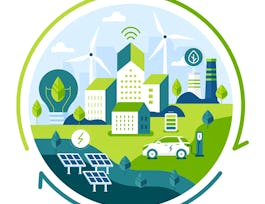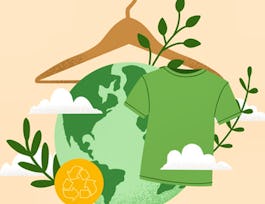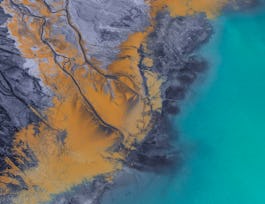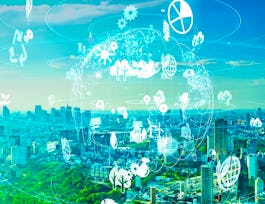As the world’s population continues to rise toward an expected 10 billion citizens by 2050, it is imperative that business practices change to ensure a high quality of life is possible for all of us, both human and non-human. Today’s learners are very aware of this. Moreover, they are highly motivated and have the extraordinary capacity to create a future that provides both economic success and a more enduring, resilient, and sustainable planet. If you are one of these learners, then Sustainability and the Circular Economy is a course for you.




Sustainability and the Circular Economy
This course is part of Applied Sustainability for Technical Managers Specialization

Instructor: Michael J. Readey, Ph.D.
Top Instructor
Sponsored by Barbados NTI
3,165 already enrolled
(41 reviews)
Recommended experience
What you'll learn
Understand the reasons for climate change and its ramifications.
Explain how power is generated today, and its associated impact on global warming.
Recognize how sustainability applies to transportation, homes and cities, food and fashion.
Describe the principles of the Circular Economy, and how the Butterfly Diagram can be used in product design.
Details to know

Add to your LinkedIn profile
23 assignments
See how employees at top companies are mastering in-demand skills

Build your subject-matter expertise
- Learn new concepts from industry experts
- Gain a foundational understanding of a subject or tool
- Develop job-relevant skills with hands-on projects
- Earn a shareable career certificate


Earn a career certificate
Add this credential to your LinkedIn profile, resume, or CV
Share it on social media and in your performance review

There are 6 modules in this course
Welcome to Sustainability and the Circular Economy! This first module introduces the course and how it operates. It then exposes you to the major challenges facing the world today, such as climate change, ocean acidification, biodiversity loss, plastic pollution and social inequity. We capture this with a discussion of planetary boundaries (Rockstrom) and the concept of the Anthropocene. The module ends on a high note with people and organizations that are making real change possible.
What's included
11 videos5 readings3 assignments2 discussion prompts
This module introduces the classic definition of sustainability and sustainable development (Brundtland Commission), along with contemporary concepts of regenerative and restorative practices. We discuss the IPAT equation as a means of providing a macro-view of environmental impacts as a function of population and affluence. The UN Sustainable Development Goals are covered, with a view to how business can impact these in a positive way. The module concludes with an overview of neoliberal economics and the resulting wealth inequality it led to, and a more positive, inclusive model proposed by Kate Raworth in her book, "Doughnut Economics".
What's included
6 videos1 reading1 assignment1 peer review1 discussion prompt
This module opens with an overview of the greenhouse effect resulting from greenhouse gases, both good and bad. We then illustrate from the Keeling Curve that GHGs are increasing and have been markedly since the dawn of the industrial revolution. We then discuss the relationship between GHGs and anthropogenic sources, meaning mostly fossil fuels, and the evidence linking the two. We cover the Carbon Dioxide Equivalent, and how one calculates it from GHG emissions and their respective global warming potentials (GWP). The Albedo Effect is then covered as a reinforcing mechanism to climate change. Finally, the module covers the Paris Accord and the need for change.
What's included
9 videos5 assignments
This module is all about conventional power generation using coal, natural gas and nuclear energy. The module begins with how coal, oil and natural gas are formed millions of years ago. We then discuss basic units of heat, power and energy, using both English and International units to communicate in a bilingual way. We dive deeper into nuclear energy, its pros and cons, and whether it should be part of a zero-carbon future. The module wraps up with a discussion of the UN's initiatives called Conference of Parties, or COP, and the resulting outcome of the Paris Climate Accord to limit global warming to 2.0o Celsius.
What's included
9 videos5 assignments1 discussion prompt
Now that you understand the global challenges facing all of us, this module showcases the emerging solutions demonstrating the value of sustainable products and to identify them. We cover the areas of transportation, noting the rapid transition to Electric Vehicles, and and developments in E-Planes. As billions of people across the globe migrate to the cities to live and work, there is considerable opportunity to design/redesign cities to be more livable, and this module highlights several successes across the world, including green building and retrofit techniques. We then explore sustainability in daily life, discussing the emerging area of Regenerative Agriculture, the process of growing more nutritious food with zero synthetic inputs, while benefitting the soil. How that food is distributed is changing as well, as consumers everywhere are paying attention not only to what they eat but who is providing it. The module then discusses the clothes that we wear, as consumers are becoming increasingly aware that what they put on their bodies is as important as what they put in their bodies. Apparel and the fashion industry are one of the greatest polluters of all industries, and consumers are demanding change. We wrap-up this module with a discussion of how Fast Fashion is giving way to a new model of Slow Fashion.
What's included
12 videos3 readings5 assignments1 discussion prompt
In this final module, we transition from greenhouse gases, climate change and power generation to the product lifecycle, introducing the concept of the Circular Economy, and how it differs from today's linear economy. We begin with a brief overview of the linear economy, and how it is challenged to support 8 Billion people on the planet. We then show the three basic principles of the Circular Economy, and how it decouples economic growth from resource extraction. We emphasize the work of the Ellen MacArthur Foundation, going through the Circular Economy Butterfly Diagram in detail, with many examples highlighting how this is put into practice. We conclude with an overview of the recycling process, its successes and current challenges.
What's included
6 videos3 readings4 assignments1 peer review1 discussion prompt
Instructor

Why people choose Coursera for their career




Learner reviews
41 reviews
- 5 stars
87.80%
- 4 stars
7.31%
- 3 stars
0%
- 2 stars
2.43%
- 1 star
2.43%
Showing 3 of 41
Reviewed on Jan 2, 2025
This has been an amazing course. The content gives you a good introduction to Sustainability and Circular Economy. I really enjoyed the videos and learned a lot from the content
Reviewed on Oct 20, 2024
Course content was relevant well explained by the professor. It was interesting throughout the course module. Happy to finish it within timeline.
Reviewed on Apr 14, 2024
I really like this course and also i learn manymore unknown details about our economy and sustainability.
Recommended if you're interested in Physical Science and Engineering

University of Colorado Boulder

University of Colorado Boulder

Lund University

University of London

Open new doors with Coursera Plus
Unlimited access to 10,000+ world-class courses, hands-on projects, and job-ready certificate programs - all included in your subscription
Advance your career with an online degree
Earn a degree from world-class universities - 100% online
Join over 3,400 global companies that choose Coursera for Business
Upskill your employees to excel in the digital economy




